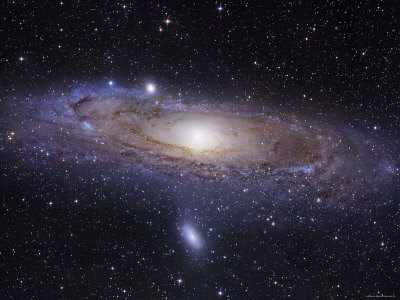Many a Sight for the Starry-Eyed
September evening skies present many delightful sights for new and
experienced stargazers alike. There is much to see no matter whether you
observe with binoculars, a telescope, or just your eyes. Go outside on a
clear, moonless night and enjoy the view!
The distinctive W-shape of Cassiopeia, a mythical Queen, is high in the
northeastern sky. Her husband Cepheus and daughter Andromeda are by her
side. Nearby you will find the Andromeda Galaxy, M31, the most distant
object visible to the unaided eye. Look for an elongated smudge of light
on a clear dark night. Can you see it? The light from the Andromeda
Galaxy started its journey to us over 2 million years ago!

Click Here for Information or to Buy this Print
Directly overhead lies the well known and prominent star pattern known
as the Summer Triangle. Two other geometrical star patterns are also
visible -- the Great Square of Pegasus and the much fainter Circlet in
Pisces. In the opposite part of the sky, The Big Dipper as always points
dutifully to Polaris, the North Star.
The Milky Way region around Sagittarius is home to many fine celestial
objects. Use a pair of binoculars to scan the star clusters and nebulae
near The Teapot. Indeed, why not follow the path of the Milky Way across
the sky starting from the two star clusters M6 and M7 in Scorpius until
you reach the Double Cluster in Perseus. Along the way see if you can
detect M27, the Dumbbell Nebula.
Epsilon Lyrae, the famous Double Double near Vega, is a striking
quadruple star system. Binoculars show a double star, but a small
telescope at high magnification will reveal each "star" to be in fact
double. A short star-hop away are two other impressive telescopic
objects -- M57, the famous Ring Nebula which resembles a smoke-ring in
the sky, and Albireo, a beautiful double star whose components shine
with contrasting colors of orange and blue-green. The Celestial Objects
list that accompanies the sky map each month contains many more examples
of interesting things to see in the night sky.
Finally, the planet Venus is visible as a brilliant white beacon low in the
western sky soon after sunset. Clear skies till next month!
Related Links:
Related Books:


